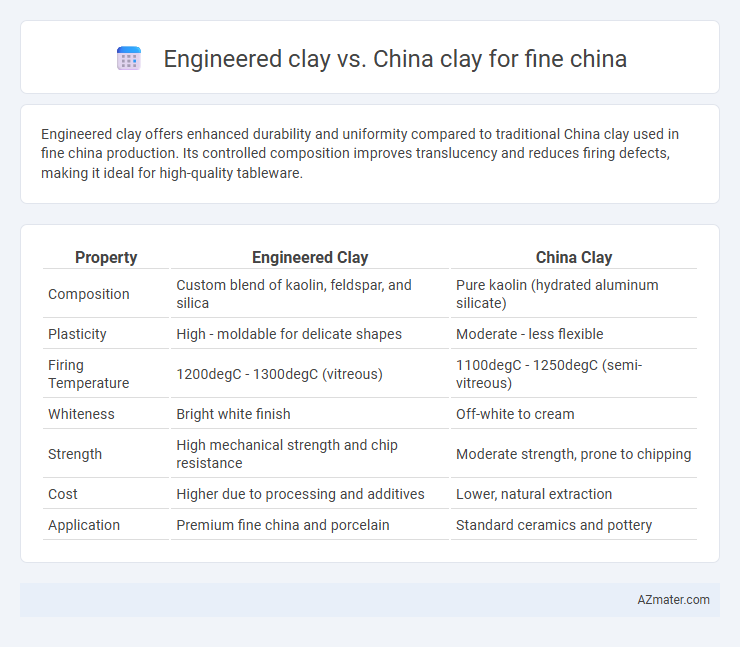Engineered clay offers enhanced durability and uniformity compared to traditional China clay used in fine china production. Its controlled composition improves translucency and reduces firing defects, making it ideal for high-quality tableware.
Table of Comparison
| Property | Engineered Clay | China Clay |
|---|---|---|
| Composition | Custom blend of kaolin, feldspar, and silica | Pure kaolin (hydrated aluminum silicate) |
| Plasticity | High - moldable for delicate shapes | Moderate - less flexible |
| Firing Temperature | 1200degC - 1300degC (vitreous) | 1100degC - 1250degC (semi-vitreous) |
| Whiteness | Bright white finish | Off-white to cream |
| Strength | High mechanical strength and chip resistance | Moderate strength, prone to chipping |
| Cost | Higher due to processing and additives | Lower, natural extraction |
| Application | Premium fine china and porcelain | Standard ceramics and pottery |
Introduction to Engineered Clay and China Clay
Engineered clay, composed of refined minerals blended for enhanced plasticity and strength, offers superior workability and consistency in fine china production. China clay, also known as kaolin, is a naturally occurring white clay primarily valued for its purity, whiteness, and refractory properties essential in traditional porcelain manufacturing. The controlled composition of engineered clay allows for improved structural integrity and reduced firing defects compared to the natural variability found in China clay.
Composition Differences Between Engineered Clay and China Clay
Engineered clay for fine china typically consists of a carefully controlled blend of kaolin, feldspar, and quartz, optimized for enhanced plasticity, strength, and whiteness. China clay, also known as kaolin, primarily comprises fine-grained kaolinite mineral, providing excellent whiteness and purity but with less mechanical strength compared to engineered clay blends. The key compositional difference lies in engineered clay's additional fluxing agents and fillers that improve firing behavior and finished product durability in fine china.
Processing Methods for Engineered Clay vs China Clay
Engineered clay for fine china undergoes precise blending of natural clays, minerals, and additives, followed by controlled extrusion and firing to achieve consistent particle size and enhanced strength. China clay, also known as kaolin, is processed primarily through wet mining, refining to remove impurities, and drying without significant modification, preserving its natural purity and fine particle distribution. The engineered clay process emphasizes uniformity and tailored properties, while china clay processing focuses on maintaining natural composition and quality.
Physical Properties Relevant to Fine China Production
Engineered clay offers enhanced consistency in particle size distribution and plasticity, resulting in improved moldability and reduced shrinkage during firing compared to natural China clay. China clay, known for its high kaolinite content and whiteness, provides excellent whiteness and translucency critical for fine china aesthetics but may exhibit higher variability in physical properties. The low iron oxide content in engineered clay minimizes discoloration, while its optimized rheological properties contribute to increased strength and durability of fine china products.
Effects on Fine China Strength and Durability
Engineered clay offers enhanced strength and durability for fine china by incorporating controlled mineral compositions and refined particle sizes that improve structural integrity and reduce porosity. China clay, also known as kaolin, provides a traditional base with high whiteness and plasticity, but may result in more brittle finished products due to its natural variability and lower mechanical strength. The optimized use of engineered clay in fine china production leads to superior resistance to chipping, thermal shock, and long-term wear compared to standard china clay formulations.
Whiteness and Aesthetic Qualities in Fine China
Engineered clay offers superior control over whiteness levels and translucency compared to natural China clay, enabling finer and more consistent aesthetic qualities in fine china production. Precise particle size distribution and chemical purity in engineered clays result in enhanced whiteness, brightness, and smoother surface finishes. Natural China clay, while traditionally valued, often presents variability in color and texture that can affect the uniformity and elegance required in premium fine china.
Impact on Glaze Performance and Surface Finish
Engineered clay offers a more uniform particle size distribution compared to traditional China clay, resulting in enhanced glaze adhesion and improved surface finish quality in fine china production. The controlled composition of engineered clay reduces defects like blistering and crazing during firing, ensuring a smoother and more durable glaze layer. In contrast, China clay's natural variability can lead to inconsistencies in glaze performance, affecting the final aesthetic and physical properties of fine china products.
Cost Comparison: Engineered Clay vs China Clay
Engineered clay typically incurs higher upfront costs due to advanced manufacturing processes and enhanced material properties, while china clay remains a more economical option because of its widespread availability and traditional extraction methods. Cost efficiency of china clay makes it preferable for large-scale fine china production where budget constraints are critical. However, engineered clay's investment often translates to reduced defects and improved durability, potentially lowering long-term expenses despite the initial higher price.
Environmental Considerations in Clay Sourcing and Use
Engineered clay for fine china offers reduced environmental impact by minimizing mining disturbances and allowing precise resource control compared to traditional China clay, which often involves extensive open-pit extraction causing habitat disruption and soil erosion. The lower impurities and tailored composition of engineered clay enhance production efficiency, reducing energy consumption and waste during firing processes. Sustainable sourcing of engineered clays supports circular economy principles by enabling recycling and reuse, whereas China clay extraction frequently contributes to significant landscape degradation and increased carbon emissions due to transportation and processing.
Conclusion: Choosing the Optimal Clay for Fine China
Engineered clay offers consistent particle size and enhanced plasticity, resulting in finer detail and reduced firing defects compared to traditional China clay. China clay, or kaolin, provides superior whiteness and thermal stability essential for high-quality fine china. Selecting the optimal clay depends on balancing the precision of engineered clays with the purity and heat resistance of natural China clay for the desired final product characteristics.

Infographic: Engineered clay vs China clay for Fine china
 azmater.com
azmater.com